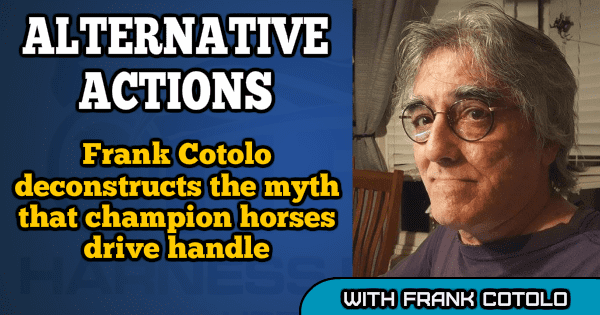Alternative Actions: Deconstructing the commercial value of champion horses
…or Mickey Mantle’s dead; long live Mickey Mantle.
by Frank Cotolo
When it comes to methods for racetrack management in pursuit of the “partner” goal with patrons, the possibilities flow like wine when the concentration is totally on gambling. The efforts mean, of course, eliminating old and tired theories about how to keep regular patrons and attract new ones. This month, let’s look at quashing one particular tenet among industry insiders about attracting bettors.
It boils down to an idea accepted as truth that no one can prove. Here is that tenet:
Champion horses are popular horses; popular horses obtain large fan bases; large fan bases result in a broader audience; a broader audience supports a larger handle. Of course, then, a larger handle assures a racetrack’s financial success.
For decades this has been a myopic point of view for the business of pari-mutuel raceways because it relies upon a central source that is terminal in the sense that no central source can maintain any business, no less a spectator sport, no less one that relies upon spectators to participate.
As a case in point, we analyze many spectator sports supported solely by attendance. As well, we use a particular time in history.
Where there is statistical proof that the presence of Mickey Mantle on the New York Yankees contributed to higher attendances at the baseball team’s home games, a full measure of the result includes other ingredients. Thus, Mickey Mantle would be but a single element attracting fans. So, if the stadium was, let’s say, sold out, it would be due very little to the “attraction” of Mickey Mantle as much as it would be due to a combination of attractions.
For instance, a sold-out game also included fans of Roger Maris; fans of Roger Maris homeruns during the season he challenged Babe Ruth’s one-season homerun record, which included a challenge by Mickey Mantle, which is, in itself, another factor; fans of the wild field antics of manager Casey Stengel; less-popular members of the team such as Tom Tresh, Clete Boyer, Tony Kubek, Elston Howard, Whitey Ford, et al.; the generic lure of visiting Yankee Stadium, a historic New York structure; and among many more, the most obvious and banal — baseball fans.
Two decades later, at Western Harness Racing’s fall meet at Hollywood Park, the apron is barely sprinkled with a nighttime harness racing audience. No one — and I mean no one — is there solely to watch a harness race for the sake of its two-or-so minutes of action or the specific achievements such action may contribute to the sport in general. There are only bettors present, bettors, by the way, who are so dedicated to wagering they have paid admission and a parking fee to be there.
A special night in 1980 was designated at the Hollywood Park harness meet. The great sophomore pacer, Niatross, was coming to town. Niatross, one of the most praised and accomplished equine performers of the twentieth century, was set to compete in a dwindling west-coast event called the American Pacing Classic. The 1 & 1/8-mile race was, for all due purposes, an excuse to play host to the great pacer and boost business on a race circuit shrinking faster than Hank Pym became Ant-Man.
The race itself was merely a showcase for Niatross. He was set to face four inferior foes. Still, it was the biggest thing to happen at Hollywood Park harness in years and expectation for a large crowd was high. There was much media advertising and news coverage throughout the Inland Empire. Niatross was the central source for a business boon, thought promoters, who even had the Inglewood Police Department work overtime on Century Boulevard to control the expected traffic congestion.
I attended that evening, but, then again, I attended most harness programs. I can attest to the fact that there were few people other than the usual suspects, all bettors. I do not have specific figures for any increase in attendance that evening, but I know that the appearance of Niatross made little difference. Most of the bettors, in fact, did not even revel in the pacer’s 1:52.1 mile rate record in which he won, because none of the bettors cared much for such details. All of the regular bettors embraced the following race with more enthusiasm, in fact, because the Niatross race was not much of a gambling affair.
I realize that later in 1980, when Niatross paced his final race at Pompano, 23,000 people showed up. But Pompano in 1980 was a thriving raceway business, a seasonal affair with no harness-racing competition. The point is that Pompano does not survive today due to the theory in question.
The more important point is that gamblers keep all pari-mutuels tracks in business and the main attraction is never a particular performer. Champion racehorses of any breed are never responsible for anything but their places in history.

















